Assessment |
Biopsychology |
Comparative |
Cognitive |
Developmental |
Language |
Individual differences |
Personality |
Philosophy |
Social |
Methods |
Statistics |
Clinical |
Educational |
Industrial |
Professional items |
World psychology |
Animals · Animal ethology · Comparative psychology · Animal models · Outline · Index
| ?Wasps | ||||||||
|---|---|---|---|---|---|---|---|---|
 Aleiodes indiscretus
parasitizing a gypsy moth caterpillar | ||||||||
| Scientific classification | ||||||||
| ||||||||
|
Apocrita |

Wasp ocelli (simple eyes) and dorsal part of the compound eyes; also showing fine, unbranched hairs
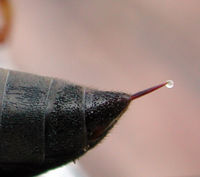
Wasp stinger, with droplet of venom
A wasp is any insect of the order Hymenoptera and suborder Apocrita that is not a bee or ant. The suborder Symphyta includes the sawflies and wood wasps, which differ from members of Apocrita by having a broader connection between the mesosoma and metasoma. In addition to this, Symphyta larvae are mostly herbivorous and "caterpillarlike", whereas those of Apocrita are largely predatory or "parasitic" (technically known as parasitoid).
The most familiar wasps belong to Aculeata, a division of Apocrita, whose ovipositors are adapted into a venomous stinger. Aculeata also contains ants and bees. In this respect, insects called "velvet ants" (the family Mutillidae) are technically wasps.
A much narrower and simpler but popular definition of the term wasp is any member of the Aculeate family Vespidae, which includes (among others) the genera known in North America as yellowjackets (Vespula and Dolichovespula) and hornets (Vespa).
Categorization[]
The various species of wasp fall into one of two main categories: solitary wasps and social wasps. Adult solitary wasps generally live and operate alone, and most do not construct nests; all adult solitary wasps are fertile. By contrast, social wasps exist in colonies numbering up to several thousand strong and build nests—but in some cases not all of the colony can reproduce. Generally, just the queen and male wasps can mate, whilst the majority of the colonies are made up of sterile female workers.
Characteristics[]
The following characteristics are present in most wasps:
- two pairs of wings (except wingless or brachypterous forms in all female Mutillidae, Bradynobaenidae, many male Agaonidae, many female Ichneumonidae, Braconidae, Tiphiidae, Scelionidae, Rhopalosomatidae, Eupelmidae, and various other families).
- An ovipositor, or stinger (which is only present in females because it derives from the ovipositor, a female sex organ).
- Few or no hairs (in contrast to bees); except Mutillidae, Bradynobaenidae, Scoliidae.
- Nearly all wasps are terrestrial; only a few specialized parasitic groups are aquatic.
- Predators or parasitoids, mostly on other terrestrial insects; some species of Pompilidae, such as the tarantula hawk, specialize in using spiders as prey, and various parasitic wasps use spiders or other arachnids as reproductive hosts.
Wasps are critically important in natural biocontrol. Almost every pest insect species has a wasp species that is a predator or parasite upon it. Parasitic wasps are also increasingly used in agricultural pest control as they have little impact on crops. Wasps also constitute an important part of the food chain.
Biology[]
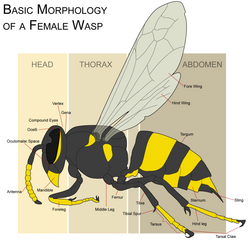
The basic morphology of a female yellowjacket wasp
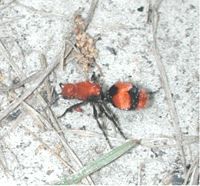
A "velvet ant"; a flightless wasp in the family Mutillidae

A sphecid wasp from California
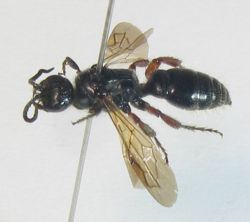
Tiphiid wasp
Genetics[]
In wasps, as in other Hymenoptera, sexes are significantly genetically different. Females have a diploid (2n) number of chromosomes and come about from fertilized eggs. Males, in contrast, have a haploid (n) number of chromosomes and develop from an unfertilized egg. Wasps store sperm inside their body and control its release for each individual egg as it is laid; if a female wishes to produce a male egg, she simply lays the egg without fertilizing it. Therefore, under most conditions in most species, wasps have complete voluntary control over the sex of their offspring.
Anatomy and gender[]
Anatomically, there is a great deal of variation between different species of wasp. Like all insects, wasps have a hard exoskeleton covering their 3 main body parts. These parts are known as the head, metasoma and mesosoma. Wasps also have a constricted region joining the first and second segments of the abdomen (the first segment is part of the mesosoma, the second is part of the metasoma) known as the petiole. Like all insects, wasps have 3 sets of 2 legs. In addition to their compound eyes, wasps also have several simple eyes known as ocelli. These are typically arranged in a triangular formation just forward of an area of the head known as the vertex.
It is possible to distinguish between certain wasp species genders based on the number of divisions on their antennae. Male Yellowjacket wasps for example have 13 divisions per antenna, while females have 12. Males can in some cases be differentiated from females by virtue of the fact that the upper region of the male's mesosoma(called the tergum) consists of an additional terga. The total number of terga is typically 6. The difference between sterile female worker wasps and queens also varies between species but generally the queen is noticeably larger than both males and other females.
Wasps can be differentiated from bees as bees have a flattened hind basitarsus. Unlike bees, wasps generally lack plumose hairs. They vary in the number and size of hairs they have between species.
Diet[]
Generally wasps are parasites as larvae, and feed only on nectar as adults. Though relatively uncommon, some wasps are omnivorous, feeding on a variety of fallen fruit, nectar, and carrion. Many wasps are predatory, preying on other insects. Certain social wasp species, such as yellowjackets, scavenge for dead insects to provide for their young. In turn the brood provides sweet secretions for the adults.
In parasitic species, the first meals are almost always provided by the animal that the adult wasp used as a host for its young. Adult male wasps sometimes visit flowers to obtain nectar to feed on in much the same manner as honey bees. Occasionally, some species, such as yellowjackets, invade honeybee nests and steal honey and/or brood.[How to reference and link to summary or text]
Wasp parasitism[]
With most species, adult parasitic wasps themselves do not take any nutrients from their prey, and, much like bees, butterflies, and moths, they typically derive all of their nutrition from nectar. Parasitic wasps are typically parasitoids, and extremely diverse in habits, many laying their eggs in inert stages of their host (egg or pupa), or sometimes paralyzing their prey by injecting it with venom through their ovipositor. They then insert one or more eggs into the host or deposit them upon the host externally. The host remains alive until the parasitoid larvae are mature, usually dying either when the parasitoids pupate, or when they emerge as adults.
Social wasp reproductive cycle (temperate species only)[]
Wasps do not reproduce via mating flights like bees. Instead social wasps reproduce between a fertile queen and male wasp; in some cases queens may be fertilized by the sperm of several males. After successfully mating, the male's sperm cells are stored in a tightly packed ball inside the queen. The sperm cells are kept stored in a dormant state until they are needed the following spring. At a certain time of the year (often around autumn), the bulk of the wasp colony dies away, leaving only the young mated queens alive. During this time they leave the nest and find a suitable area to hibernate for the winter.
First stage[]
After emerging from hibernation during early spring, the young queens search for a suitable nesting site. Upon finding an area for their future colony, the queen constructs a basic paper fiber nest roughly the size of a walnut into which she will begin to lay eggs.
Second stage[]
The sperm that was stored earlier and kept dormant over winter is now used to fertilize the eggs being laid. The storage of sperm inside the female queen allows her to lay a considerable number of fertilized eggs without the need for repeated mating with a male wasp. For this reason a single female queen is capable of building an entire colony from only herself. The queen initially raises the first several sets of wasp eggs until enough sterile female workers exist to maintain the offspring without her assistance. All of the eggs produced at this time are sterile female workers who will begin to construct a more elaborate nest around their queen as they grow in number.
Third stage[]
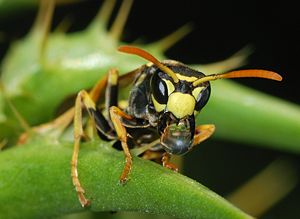
European paper wasp (Polistes dominulus) evaporating water from a regurgitated droplet to cool herself
By this time the nest size has expanded considerably and now numbers between several hundred and several thousand wasps. Towards the end of the summer, the queen begins to run out of stored sperm to fertilize more eggs. These eggs develop into fertile males and fertile female queens. The male drones then fly out of the nest and find a mate thus perpetuating the wasp reproductive cycle. In most species of social wasp the young queens mate in the vicinity of their home nest and do not travel like their male counterparts do. The young queens will then leave the colony to hibernate for the winter once the other worker wasps and founder queen have started to die off. After successfully mating with a young queen, the male drones die off as well. Generally, young queens and drones from the same nest do not mate with each other; this ensures more genetic variation within wasp populations, especially considering that all members of the colony are theoretically the direct genetic descendants of the founder queen and a single male drone. In practice, however, colonies can sometimes consist of the offspring of several male drones. Wasp queens generally (but not always) create new nests each year, probably because the weak construction of most nests render them uninhabitable after the winter.
Unlike most honey bee queens, wasp queens typically only live for one year (although exceptions are possible). Also, contrary to popular belief queen wasps do not organize their colony or have any raised status and hierarchical power within the social structure. They are more simply the reproductive element of the colony and the initial builder of the nest in those species which construct nests.
Wasp caste structure[]
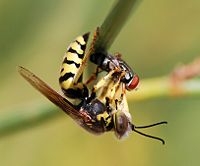
Sand wasp (Bembix oculata, family Crabronidae) removing body fluids from a fly after having paralysed it with the sting
Not all social wasps have castes that are physically different in size and structure. In many polistine paper wasps and stenogastrines, for example, the castes of females are determined behaviorally, through dominance interactions, rather than having caste predetermined. All female wasps are potentially capable of becoming a colony's queen and this process is often determined by which female successfully lays eggs first and begins construction of the nest. Evidence suggests that females compete amongst each other by eating the eggs of other rival females. The queen may, in some cases, simply be the female that can eat the largest volume of eggs while ensuring that her own eggs survive (often achieved by laying the most). This process theoretically determines the strongest and most reproductively capable female and selects her as the queen. Once the first eggs have hatched, the subordinate females stop laying eggs and instead forage for the new queen and feed the young; that is, the competition largely ends, with the losers becoming workers, though if the dominant female dies, a new hierarchy may be established with a former "worker" acting as the replacement queen. Polistine nests are considerably smaller than many other social wasp nests, typically housing only around 250 wasps, compared to the several thousand common with yellowjackets, and stenogastrines have the smallest colonies of all, rarely with more than a dozen wasps in a mature colony.
Nesting habits[]

A wasp gathering wood fibers
Polistes dominulus building nest
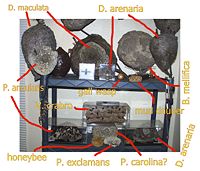
Various wasp nests
The type of nest produced by wasps can depend on the species and location. Many social wasps produce paper pulp nests on trees, in attics, holes in the ground or other such sheltered areas with access to the outdoors. By contrast solitary wasps are generally parasitic or predatory and only the latter build nests at all. Unlike honey bees, wasps have no wax producing glands. Many instead create a paper-like substance primarily from wood pulp. Wood fibers are gathered locally from weathered wood, softened by chewing and mixing with saliva. The pulp is then used to make combs with cells for brood rearing. More commonly, nests are simply burrows excavated in a substrate (usually the soil, but also plant stems), or, if constructed, they are constructed from mud.
Solitary wasps[]
The nesting habits of solitary wasps are more diverse than those of social wasps. Mud daubers and pollen wasps construct mud cells in sheltered places typically on the side of walls. Potter wasps similarly build vase-like nests from mud, often with multiple cells, attached to the twigs of trees or against walls. Most other predatory wasps burrow into soil or into plant stems, and a few do not build nests at all and prefer naturally occurring cavities, such as small holes in wood. A single egg is laid in each cell, which is sealed thereafter, so there is no interaction between the larvae and the adults, unlike in social wasps. In some species, male eggs are selectively placed on smaller prey, leading to males being generally smaller than females.
Social wasps[]
The nests of some social wasps, such as hornets, are first constructed by the queen and reach about the size of a walnut before sterile female workers take over construction. The queen initially starts the nest by making a single layer or canopy and working outwards until she reaches the edges of the cavity. Beneath the canopy she constructs a stalk to which she can attach several cells; these cells are where the first eggs will be laid. The queen then continues to work outwards to the edges of the cavity after which she adds another tier. This process is repeated, each time adding a new tier until eventually enough female workers have been born and matured to take over construction of the nest leaving the queen to focus on reproduction. For this reason, the size of a nest is generally a good indicator of approximately how many female workers there are in the colony. Social wasp colonies often have populations exceeding several thousand female workers and at least one queen. Polistes and some related types of paper wasp do not construct their nests in tiers but rather in flat single combs.
Common families[]
- Agaonidae - fig wasps
- Chalcididae
- Chrysididae - cuckoo wasps
- Crabronidae - sand wasps and relatives, e.g. the Cicada killer wasp
- Cynipidae - gall wasps
- Encyrtidae
- Eulophidae
- Eupelmidae
- Ichneumonidae, and Braconidae
- Mutillidae - velvet ants
- Mymaridae - fairyflies
- Pompilidae - spider wasps
- Pteromalidae
- Scelionidae
- Scoliidae - scoliid wasps
- Sphecidae - digger wasps
- Tiphiidae - flower wasps
- Torymidae
- Trichogrammatidae
- Vespidae - yellowjackets, hornets, paper wasps (umbrella), potter wasps, pollen wasps
See also[]
- Advertising colouration
- Common wasp
- Parasitic wasps, a diverse group of wasps
- Characteristics of common wasps and bees
- Volucella pellucens
- Mud daubers, a common group of wasps
- Bee-eaters, bird predators of wasps
- Tarantula hawk
References[]
- Abe, J., Kamimura, Y., & Shimada, M. (2005). Individual sex ratios and offspring emergence patterns in a parasitoid wasp, Melittobia australica (Eulophidae), with superparasitism and lethal combat among sons: Behavioral Ecology and Sociobiology Vol 57(4) Feb 2005, 366-373.
- Altenburg, K. R. (2000). Construction of yellowjacket wasp nests: Internal models or collective reactive behavior? (vespula, dolichovespula). Dissertation Abstracts International: Section B: The Sciences and Engineering.
- Araujo, M. S., & Gonzaga, M. O. (2007). Individual specialization in the hunting wasp Trypoxylon (Trypargilum) albonigrum (Hymenoptera, Crabronidae): Behavioral Ecology and Sociobiology Vol 61(12) Oct 2007, 1855-1863.
- Armstrong, T. R., & Stamp, N. E. (2003). Effects of prey quantity on predatory wasps ( Polistes dominulus ) when patch quality differs: Behavioral Ecology and Sociobiology Vol 54(3) Aug 2003, 310-319.
- Asis, J. D. (2003). Nesting Biology of Microstigmus thripoctenus Richards, with a Study on Nest Recognition (Hymenoptera: Crabronidae): Journal of Insect Behavior Vol 16(1) Jan 2003, 49-65.
- Asis, J. D., Beneitez, A., Tormos, J., Gayubo, S. F., & Tome, M. A. M. (2007). The significance of the vestibular cell in trap nesting wasps (Hymenoptera: Crabronidae): Does its presence reduce mortality? : Journal of Insect Behavior Vol 20(2) Mar 2007, 289-305.
- Asis, J. D., Tormos, J., & Gayubo, S. F. (2006). Territorial dynamics and contest behaviour in the solitary wasp Stizus continuus (Hymenoptera: Apoidea: Crabronidae): Behaviour Vol 143(1) Jan 2006, 83-104.
- Baeder, J. M., & King, B. H. (2004). Associative learning of color by males of the parasitoid wasp Nasonia vitripennis (Hymenoptera: Pteromalidae): Journal of Insect Behavior Vol 17(2) Mar 2004, 201-213.
- Bernal, J. S., & Luck, R. F. (2007). Mate finding via a trail sex pheromone by Aphytis melinus DeBach (Hymenoptera: Aphelinidae) males: Journal of Insect Behavior Vol 20(6) Nov 2007, 515-525.
- Bhadra, A., Iyer, P. L., Sumana, A., Deshpande, S. A., Ghosh, S., & Gadagkar, R. (2007). How do workers of the primitively eusocial wasp Ropalidia marginata detect the presence of their queens? : Journal of Theoretical Biology Vol 246, 574-582.
- Bleeker, M. A. K., Smid, H. M., Steidle, J. L. M., Kruidhof, H. M., Van Loon, J. J. A., & Vet, L. E. M. (2006). Differences in memory dynamics between two closely related parasitoid wasp species: Animal Behaviour Vol 71(6) Jun 2006, 1343-1350.
- Bouwma, A. M., Howard, K. J., & Jeanne, R. L. (2005). Parasitism in a social wasp: Effect of gregarines on foraging behavior, colony productivity, and adult mortality: Behavioral Ecology and Sociobiology Vol 59(2) Dec 2005, 222-233.
- Bouwma, A. M., Howard, K. J., & Jeanne, R. L. (2006). "Parasitism in a social wasp: Effect of gregarines on foraging behavior, colony productivity, and adult mortality": Erratum: Behavioral Ecology and Sociobiology Vol 60(3) Jul 2006, 455.
- Brennan, B. J. (2007). Abdominal wagging in the social paper wasp Polistes dominulus: Behavior and substrate vibrations: Ethology Vol 113(7) Jul 2007, 692-702.
- Bridge, C., & Field, J. (2007). Queuing for dominance: Gerontocracy and queue-jumping in the hover wasp Liostenogaster flavolineata: Behavioral Ecology and Sociobiology Vol 61(8) Jun 2007, 1253-1259.
- Brown, J. S. L., Abrahams, S., & Helbert, M. (2003). An unusual case of a wasp phobic: Journal of Behavior Therapy and Experimental Psychiatry Vol 34(3-4) Sep-Dec 2003, 219-224.
- Bruyndonckx, N., Kardile, S. P., & Gadagkar, R. (2006). Dominance behaviour and regulation of foraging in the primitively eusocial wasp Ropalidia marginata (Lep.) (Hymenoptera: Vespidae): Behavioural Processes Vol 72(1) Mar 2006, 100-103.
- Burger, J. M. S., Huang, Y., Hemerik, L., Van Lenteren, J. C., & Vet, L. E. M. (2006). Flexible Use of Patch-Leaving Mechanisms in a Parasitoid Wasp: Journal of Insect Behavior Vol 19(2) Mar 2006, 155-170.
- Burton-Chellew, M. N., Beukeboom, L. W., West, S. A., & Shuker, D. M. (2007). Laboratory evolution of polyandry in the parasitoid wasp Nasonia vitripennis: Animal Behaviour Vol 74(5) Nov 2007, 1147-1154.
- Cant, M. A., & English, S. (2006). Stable group size in cooperative breeders: The role of inheritance and reproductive skew: Behavioral Ecology Vol 17(4) Jul-Aug 2006, 560-568.
- Cocroft, R. B. (2002). Antipredator defense as a limited resource: Unequal predation risk in broods of an insect with maternal care: Behavioral Ecology Vol 13(1) Jan-Feb 2002, 125-133.
- Collatz, J., Muller, C., & Steidle, J. L. M. (2006). Protein synthesis-dependent long-term memory induced by one single associative training trial in the parasitic wasp Lariophagus distinguendus: Learning & Memory Vol 13(3) May 2006, 263-266.
- Cook, J. M., & Bean, D. (2006). Cryptic male dimorphism and fighting in a fig wasp: Animal Behaviour Vol 71(5) May 2006, 1095-1101.
- Coster-Longman, C., Landi, M., & Turillazzi, S. (2002). The role of passive defense (selfish herd and dilution effect) in the gregarious nesting of Liostenogaster wasps (Vespidae, hymenoptera, stenogastrinae): Journal of Insect Behavior Vol 15(3) May 2002, 331-350.
- Cronin, A. L., & Field, J. (2007). Rank and colony defense against conspecifics in a facultatively eusocial hover wasp: Behavioral Ecology Vol 18(2) Mar-Apr 2007, 331-336.
- D'Adamo, P., Lozada, M., & Corley, J. C. (2004). An Attraction Pheromone from Heads of Worker Vespula germanica Wasps: Journal of Insect Behavior Vol 17(6) Nov 2004, 809-821.
- D'Alessandro, M., & Turlings, T. C. J. (2005). In Situ Modification of Herbivore-Induced Plant Odors: A Novel Approach to Study the Attractiveness of Volatile Organic Compounds to Parasitic Wasps: Chemical Senses Vol 30(9) Nov 2005, 739-753.
- Damiens, D., & Boivin, G. (2006). Why do sperm-depleted parasitoid males continue to mate? : Behavioral Ecology Vol 17(1) Jan-Feb 2006, 138-143.
- Dapporto, L., Pansolli, C., & Turillazzi, S. (2004). Hibernation clustering and its consequences for associative nest foundation in Polistes dominulus (Hymenoptera Vespidae): Behavioral Ecology and Sociobiology Vol 56(4) Aug 2004, 315-321.
- Dapporto, L., Santini, A., Dani, F. R., & Turillazzi, S. (2007). Workers of a Polistes paper wasp detect the presence of their queen by chemical cues: Chemical Senses Vol 32(8) Oct 2007, 795-802.
- Dapporto, L., Turillazzi, S., & Palagi, E. (2006). Dominance Interactions in Young Adult Paper Wasp (Polistes dominulus) Foundresses: A Playlike Behavior? : Journal of Comparative Psychology Vol 120(4) Nov 2006, 394-400.
- de Oliveira, L., Cunha, A. O. S., Mortari, M. R., Coimbra, N. C., & Dos Santos, W. F. (2006). Cataleptic activity of the denatured venom of the social wasp Agelaia vicina (Hymenoptera, Vespidae) in Rattus norvegicus (Rodentia, Muridae): Progress in Neuro-Psychopharmacology & Biological Psychiatry Vol 30(2) Mar 2006, 198-203.
- Djemai, I., Casas, J., & Magal, C. (2004). Parasitoid foraging decisions mediated by artificial vibrations: Animal Behaviour Vol 67(3) Mar 2004, 567-571.
- Eason, P. K., Cobbs, G. A., & Trinca, K. G. (1999). The use of landmarks to define territorial boundaries: Animal Behaviour Vol 58(1) Jul 1999, 85-91.
- Elgar, M. A., & Jebb, M. (1999). Nest provisioning in the mud-dauber wasp Sceliphron laetum (F. Smith): Body mass and taxa specific prey selection: Behaviour Vol 136(2) Mar 1999, 147-159.
- Fanelli, D., Boomsma, J. J., & Turillazzi, S. (2005). Multiple reproductive strategies in a tropical hover wasp: Behavioral Ecology and Sociobiology Vol 58(2) Jun 2005, 190-199.
- Fatouros, N. E., Bukovinszkine'Kiss, G., Dicke, M., & Hilker, M. (2007). The response specificity of trichogramma egg parasitoids towards infochemicals during host location: Journal of Insect Behavior Vol 20(1) Jan 2007, 53-65.
- Fatouros, N. E., Huigens, M. E., van Loon, J. J. A., Dicke, M., & Hilker, M. (2005). Butterfly anti-aphrodisiac lures parasitic wasps: Nature Vol 433(7027) Feb 2005, 704.
- Fauvergue, X., Boll, R., Rochat, J., Wajnberg, E., Bernstein, C., & Lapchin, L. (2006). Habitat assessment by parasitoids: Consequences for population distribution: Behavioral Ecology Vol 17(4) Jul-Aug 2006, 522-531.
- Field, J. (2005). The evolution of progressive provisioning: Behavioral Ecology Vol 16(4) Jul-Aug 2005, 770-778.
- Field, J., Cronin, A., & Bridge, C. (2006). Future fitness and helping in social queues: Nature Vol 441(7090) May 2006, 214-217.
- Field, J., Shreeves, G., Sumner, S., & Casiraghi, M. (2000). Insurance-based advantage to helpers in tropical hover wasp: Nature Vol 404(6780) Apr 2000, 869-871.
- Foster, K. R., & Ratnieks, F. L. W. (2000). Facultative worker policing in a wasp: Nature Vol 407(6805) Oct 2000, 692-693.
- Giray, T., Giovanetti, M., & West-Eberhard, M. J. (2005). Juvenile hormone, reproduction, and worker behavior in the neotropical social wasp Polistes canadensis: PNAS Proceedings of the National Academy of Sciences of the United States of America Vol 102(9) Mar 2005, 3330-3335.
- Giron, D., Dunn, D. W., Hardy, I. C. W., & Strand, M. R. (2004). Aggression by polyembryonic wasp soldiers correlates with kinship but not resource competition: Nature Vol 430(7000) Aug 2004, 676-679.
- Gohole, L. S., Overholt, W. A., Khan, Z. R., & Vet, L. E. M. (2005). Close-Range Host Searching Behavior of the Stemborer Parasitoids Cotesia sesamiae and Dentichasmias busseolae: Influence of a Non-Host Plant Melinis minutiflora: Journal of Insect Behavior Vol 18(2) Mar 2005, 149-169.
- Goubault, M., Outreman, Y., Poinsot, D., & Cortesero, A. M. (2005). Patch exploitation strategies of parasitic wasps under intraspecific competition: Behavioral Ecology Vol 16(4) Jul-Aug 2005, 693-701.
- Goubault, M., Scott, D., & Hardy, I. C. W. (2007). The importance of offspring value: Maternal defence in parasitoid contests: Animal Behaviour Vol 74(3) Sep 2007, 437-446.
- Groddeck, J., Mauss, V., & Reinhold, K. (2004). The Resource-Based Mating System of the Mediterranean Pollen Wasp Ceramius fonscolombei Latreille 1810 (Hymenoptera, Vespidae, Masarinae): Journal of Insect Behavior Vol 17(3) May 2004, 397-418.
- Grosch, D. S. (1947). The importance of antennae in mating reactions of male Habrobracon: Journal of Comparative and Physiological Psychology Vol 40(1) Feb 1947, 23-29.
- Grosch, D. S. (1948). Experimental studies on the mating reaction of male Habrobracon: Journal of Comparative and Physiological Psychology Vol 41(3) Jun 1948, 188-195.
- Gu, H., & Dorn, S. (2003). Mating system and sex allocation in the gregarious parasitoid Cotesia glomerata: Animal Behaviour Vol 66(2) Aug 2003, 259-264.
- Gunnels, C. W. I. V. (2007). Seasonally variable eusocially selected traits in the paper wasp, Mischocyttarus Mexicanus: Ethology Vol 113(7) Jul 2007, 648-660.
- Hartman, C. (1913). The habits of Eumenes belfragei cress: Journal of Animal Behavior Vol 3(5) Sep-Oct 1913, 353-360.
- Hartman, C. G. (1944). The glass tubes method for studying insect behavior: Journal of Comparative Psychology Vol 37(1) Feb 1944, 1-2.
- Henshaw, M. T., Robson, S. K. A., & Crozier, R. H. (2004). Queen number, queen cycling and queen loss: The evolution of complex multiple queen societies in the social wasp genus Ropalidia: Behavioral Ecology and Sociobiology Vol 55(5) Mar 2004, 469-476.
- Herman, R. A., Queller, D. C., & Strassmann, J. E. (2000). The role of queens in colonies of the swarm-founding wasp Parachartergus colobopterus: Animal Behaviour Vol 59(4) Apr 2000, 841-848.
- Hougardy, E., & Gregoire, J.-C. (2003). Cleptoparasitism increases the host finding ability of a polyphagous parasitoid species, Rhopalicus tutela (Hymenoptera: Pteromalidae): Behavioral Ecology and Sociobiology Vol 55(2) Dec 2003, 184-189.
- Hougardy, E., & Mills, N. J. (2007). Influence of host deprivation and egg expenditure on the patch and host-finding behavior of the parasitoid wasp Mastrus ridibundus: Journal of Insect Behavior Vol 20(2) Mar 2007, 229-246.
- Hrncir, M., Mateus, S., & Nascimento, F. S. (2007). Exploitation of carbohydrate food sources in Polybia occidentalis: Social cues influence foraging decisions in swarm-founding wasps: Behavioral Ecology and Sociobiology Vol 61(6) Apr 2007, 975-983.
- Hughes, D. P., Kathirithamby, J., Turillazzi, S., & Beani, L. (2004). Social wasps desert the colony and aggregate outside if parasitized: Parasite manipulation? : Behavioral Ecology Vol 15(6) Nov 2004, 1037-1043.
- Humphries, E. L., Hebblethwaite, A. J., Batchelor, T. P., & Hardy, I. C. W. (2006). The importance of valuing resources: Host weight and contender age as determinants of parasitoid wasp contest outcomes: Animal Behaviour Vol 72(4) Oct 2006, 891-898.
- Innocent, T. M., Savage, J., West, S. A., & Reece, S. E. (2007). Lethal combat and sex ratio evolution in a parasitoid wasp: Behavioral Ecology Vol 18(4) Jul-Aug 2007, 709-715.
- Jaloux, B., Sanon, A., Huignard, J., & Monge, J. P. (2004). Interspecific Relationships Between the Solitary Ectoparasitoid, Eupelmus vuilleti (Crw.) (Eupelmidae), and Its Sympatric Species, Dinarmus basalts (Rond.) (Pteromalidae), in the Presence of Their Host, Callosobruchus maculatus Pic (Coleoptera Bruchidae): Journal of Insect Behavior Vol 17(6) Nov 2004, 793-808.
- Jandt, J. M., Riel, L., Crain, B., & Jeanne, R. L. (2005). Vespula germanica Foragers Do Not Scent-Mark Carbohydrate Food Sites: Journal of Insect Behavior Vol 18(1) Jan 2005, 19-31.
- Jha, S., Casey-Ford, R. G., Pedersen, J. S., Platt, T. G., Cervo, R., Queller, D. C., et al. (2006). The queen is not a pacemaker in the small-colony wasps Polistes instabilis and P. dominulus: Animal Behaviour Vol 71(5) May 2006, 1197-1203.
- Judd, T. M. (2000). Division of labour in colony defence against vertebrate predators by the social wasp Polistes fuscatus: Animal Behaviour Vol 60(1) Jul 2000, 55-61.
- Kemp, D. J., Alcock, J., & Allen, G. R. (2006). Sequential size assessment and multicomponent decision rules mediate aerial wasp contests: Animal Behaviour Vol 71(2) Feb 2006, 279-287.
- King, B. H. (1998). Host age response in the parasitoid wasp Spalangia cameroni (Hymenoptera: Pteromalidae): Journal of Insect Behavior Vol 11(1) Jan 1998, 103-117.
- King, B. H., & Leaich, H. R. (2006). Variation in Propensity to Exhibit Thanatosis in Nasonia vitripennis (Hymenoptera: Pteromalidae): Journal of Insect Behavior Vol 19(2) Mar 2006, 241-249.
- King, B. H., Saporito, K. B., Ellison, J. H., & Bratzke, R. M. (2005). Unattractiveness of mated females to males in the parasitoid wasp Spalangla endius: Behavioral Ecology and Sociobiology Vol 57(4) Feb 2005, 350-356.
- Kudo, K., Tsujita, S., Tsuchida, K., Goi, W., Yamane, S., Mateus, S., et al. (2005). Stable relatedness structure of the large-colony swarm-founding wasp Polybia paulista: Behavioral Ecology and Sociobiology Vol 58(1) May 2005, 27-35.
- Kumano, N., & Kasuya, E. (2001). Why do workers of the primitively eusocial wasp Polistes chinensis antennalis remain at their natal nest? : Animal Behaviour Vol 61(3) Mar 2001, 655-660.
- Lamba, S., Kazi, Y. C., Deshpande, S., Natesh, M., Bhadra, A., & Gadagkar, R. (2007). A possible novel function of dominance behaviour in queen-less colonies of the primitively eusocial wasp Ropalidia marginata: Behavioural Processes Vol 74(3) Mar 2007, 351-356.
- Leonard, J. E., & Boake, C. R. B. (2006). Site-dependent aggression and mating behaviour in three species of Nasonia (Hymenoptera: Pteromalidae): Animal Behaviour Vol 71(3) Mar 2006, 641-647.
- Liebert, A. E., & Starks, P. T. (2006). Taming of the skew: Transactional models fail to predict reproductive partitioning in the paper wasp Polistes dominulus: Animal Behaviour Vol 71(4) Apr 2006, 913-923.
- Lorenzi, M. C., Cometto, I., & Marchisio, G. (1999). Species and colony components in the recognition odor of young social wasps: Their expression and learning ( Polistes biglumis and P. atrimandibularis ; Hymenoptera: Vespidae): Journal of Insect Behavior Vol 12(2) Mar 1999, 147-158.
- Lozada, M., & D'Adamo, P. (2006). How long do Vespula germanica wasps search for a food source that is no longer available? : Journal of Insect Behavior Vol 19(5) Sep 2006, 591-600.
- Lucchetta, P., Desouhant, E., Wajnberg, E., & Bernstein, C. (2007). Small but smart: The interaction between environmental cues and internal state modulates host-patch exploitation in a parasitic wasp: Behavioral Ecology and Sociobiology Vol 61(9) Jul 2007, 1409-1418.
- Mazokhin-Porshnyakov, G. A., & Graevskaya, E. E. (1966). Recognition of coloration-combinations by insects and comparison of this ability in bees and wasps: Zhurnal Obshchei Biologii 27(1) 1966, 112-116.
- McDougall, K. D., & McDougall, W. (1931). Insight and foresight in various animals--monkey, raccoons, rat, and wasp: Journal of Comparative Psychology Vol 11(3) Feb 1931, 237-273.
- Montagner, H. (1964). Instinct and stereotyped mechanisms in the social wasps: Psychologie Francaise 9(4) 1964, 257-279.
- Moore, J. C., Pienaar, J., & Greeff, J. M. (2004). Male morphological variation and the determinants of body size in two Otiteselline fig wasps: Behavioral Ecology Vol 15(5) Sep 2004, 735-741.
- Nascimento, F. S., Hrncir, M., Tolfiski, A., & Zucchi, R. (2005). Scraping sounds produced by a social wasp (Asteloeca ujhelyii, hymenoptera: Vespidae): Ethology Vol 111(12) Dec 2005, 1116-1125.
- Naug, D., & Wenzel, J. (2006). Constraints on foraging success due to resource ecology limit colony productivity in social insects: Behavioral Ecology and Sociobiology Vol 60(1) May 2006, 62-68.
- No authorship, i. (1906). Review of Wasps Social and Solitary: Psychological Bulletin Vol 3(5) May 1906, 172-174.
- O'Donnell, S. (1998). Effects of experimental forager removals on division of labour in the primitively eusocial wasp Polistes instabilis (Hymenoptera: Vespidae): Behaviour Vol 135(2) Mar 1998, 173-193.
- O'Donnell, S. (2001). Worker biting interactions and task performance in a swarm-founding eusocial wasp (Polybia occidentalis, Hymenoptera: Vespidae): Behavioral Ecology Vol 12(3) May-Jun 2001, 353-359.
- O'Donnell, S. (2006). Polybia wasp biting interactions recruit foragers following experimental worker removals: Animal Behaviour Vol 71(3) Mar 2006, 709-715.
- Outreman, Y., Le Ralec, A., Wajnberg, E., & Pierre, J.-S. (2005). Effects of within- and among-patch experiences on the patch-leaving decision rules in an insect parasitoid: Behavioral Ecology and Sociobiology Vol 58(2) Jun 2005, 208-217.
- Outreman, Y., & Pierre, J.-S. (2005). Adaptive value of host discrimination in parasitoids: When host defences are very costly: Behavioural Processes Vol 70(2) Sep 2005, 93-103.
- Panek, L. M., Gamboa, G. J., & Espelie, K. E. (2001). The effect of a wasp's age on its cuticular hydrocarbon profile and its tolerance by nestmate and non-nestmate conspecifics (Polistes fuscatus , Hymenoptera: Vespidae): Ethology Vol 107(1) Jan 2001, 55-63.
- Pasquet, A., Cardot, J., & Leborgne, R. (2007). Wasp attacks and spider defence in the orb weaving species Zygiella x-notata: Journal of Insect Behavior Vol 20(6) Nov 2007, 553-564.
- Pereira, R. A. S., & do Prado, A. P. (2005). Recognition of competitive asymmetries reduces the severity of fighting in male Idarnes fig wasps: Animal Behaviour Vol 70(2) Aug 2005, 249-256.
- Pexton, J. J., & Mayhew, P. J. (2005). Clutch size adjustment, information use and the evolution of gregarious development in parasitoid wasps: Behavioral Ecology and Sociobiology Vol 58(1) May 2005, 99-110.
- Platt, T. G., Queller, D. C., & Strassmann, J. E. (2004). Aggression and worker control of caste fate in a multiple-queen wasp, Parachartergus colobopterus: Animal Behaviour Vol 67(1) Jan 2004, 1-10.
- Punzo, F., & Ludwig, L. (2005). Behavioral responses of Pepsis thisbe (Hymenoptera: pompilidae) to chemosensory cues associated with host spiders: Journal of Insect Behavior Vol 18(6) Nov 2005, 757-766.
- Rau, P. (1939). The instinct of animosity and tolerance in queen Polistes wasps: Journal of Comparative Psychology Vol 27(2) Apr 1939, 259-269.
- Rau, P. (1945). Caste in colonies of Polistes wasps: Journal of Comparative Psychology Vol 38(5) Oct 1945, 291-293.
- Rau, P., & Rau, N. (1916). "The biology of mud-daubing wasps": A Correction: Journal of Animal Behavior Vol 6(6) Nov-Dec 1916, 434.
- Rau, P., & Rau, N. (1916). The biology of the mud-daubing wasps as revealed by the contents of their nests: Journal of Animal Behavior Vol 6(1) Jan-Feb 1916, 27-63.
- Reece, S. E., Innocent, T. M., & West, S. A. (2007). Lethal male-male combat in the parasitoid Melittobia acasta: Are size and competitive environment important? : Animal Behaviour Vol 74(5) Nov 2007, 1163-1169.
- Sen, R., & Gadagkar, R. (2006). Males of the social wasp Ropalidia marginata can feed larvae, given an opportunity: Animal Behaviour Vol 71(2) Feb 2006, 345-350.
- Seppa, P., Queller, D. C., & Strassmann, J. E. (2002). Reproduction in foundress associations of the social wasp, Polistes Carolina: Conventions, competition, and skew: Behavioral Ecology Vol 13(4) Aug 2002, 531-542.
- Shuker, D. M., Reece, S. E., Taylor, J. A. L., & West, S. A. (2004). Wasp sex ratios when females on a patch are related: Animal Behaviour Vol 68(2) Aug 2004, 331-336.
- Siekmann, G., Keller, M. A., & Tenhumberg, B. (2004). The Sweet Tooth of Adult Parasitoid Cotesia rubecula: Ignoring Hosts for Nectar? : Journal of Insect Behavior Vol 17(4) Jul 2004, 459-476.
- Smith, A. R., O'Donnell, S., & Jeanne, R. L. (2002). Evolution of swarm communication in Eusocial wasps (Hymenoptera: Vespidae): Journal of Insect Behavior Vol 15(6) Nov 2002, 751-764.
- Stanley, H. M. (1899). Review of The Instincts and Habits of the Solitary Wasps: Psychological Review Vol 6(2) Mar 1899, 219-220.
- Steiner, S., Steidle, J. L. M., & Ruther, J. (2005). Female sex pheromone in immature insect males--a case of pre-emergence chemical mimicry? : Behavioral Ecology and Sociobiology Vol 58(2) Jun 2005, 111-120.
- Stelinski, L. L., Oakleaf, R., & Rodriguez-Saona, C. (2007). Oviposition-deterring pheromone deposited on blueberry fruit by the parsitic wasp, Diachasma alloeum: Behaviour Vol 144(4) Apr 2007, 429-445.
- Strassmann, J. E. (2004). Rank crime and punishment: Nature Vol 432(7014) Nov 2004, 160-161.
- Strohm, E., & Marliani, A. (2002). The cost of parental care: Prey hunting in a digger wasp: Behavioral Ecology Vol 13(1) Jan-Feb 2002, 52-58.
- Sumana, A., Liebert, A. E., Berry, A. S., Switz, G. T., Orians, C. M., & Starks, P. T. (2005). Nest Hydrocarbons as Cues for Philopatry in a Paper Wasp: Ethology Vol 111(5) May 2005, 469-477.
- Sumana, A., Deshpande, S. A., Bhadra, A. & Gadagkar, R. (2008). Workers of the primitively eusocial wasp Ropalidia marginata do not perceive their queens across a wire mesh partition: Journal of Ethology Vol 26: 207-212.
- Sykes, E. M., Innocent, T. M., Pen, I., Shuker, D. M., & West, S. A. (2007). Asymmetric larval competition in the parasitoid wasp Nasonia vitripennis: A role in sex allocation? : Behavioral Ecology and Sociobiology Vol 61(11) Sep 2007, 1751-1758.
- Tentelier, C., Desouhant, E., & Fauvergue, X. (2006). Habitat assessment by parasitoids: Mechanisms for patch use behavior: Behavioral Ecology Vol 17(4) Jul-Aug 2006, 515-521.
- Thiel, A., Driessen, G., & Hoffmeister, T. S. (2006). Different habitats, different habits? Response to foraging information in the parasitic wasp Venturia canescens: Behavioral Ecology and Sociobiology Vol 59(5) Mar 2006, 614-623.
- Thiel, A., & Hoffmeister, T. S. (2004). Knowing your habitat: Linking patch-encounter rate and patch exploitation in parasitoids: Behavioral Ecology Vol 15(3) May 2004, 419-425.
- Tibbetts, E. A. (2007). Dispersal decisions and predispersal behavior in Polistes paper wasp 'workers.' Behavioral Ecology and Sociobiology Vol 61(12) Oct 2007, 1877-1883.
- Tibbetts, E. A., & Curtis, T. R. (2007). Rearing conditions influence quality signals but not individual identity signals in Polistes wasps: Behavioral Ecology Vol 18(3) May-Jun 2007, 602-607.
- Tibbetts, E. A., & Dale, J. (2004). A socially enforced signal of quality in a paper wasp: Nature Vol 432(7014) Nov 2004, 218-222.
- Turner, C. H. (1912). Reactions of the Mason wasp, Trypoxylon albotarsus, to light: Journal of Animal Behavior Vol 2(5) Sep-Oct 1912, 353-362.
- Ueno, T. (1998). Sex allocation by a parasitoid wasp (Hymenoptera: Ichneumonidae) to different host species: A question for the mechanism of host size estimation: Journal of Insect Behavior Vol 11(6) Nov 1998, 811-821.
- van Baaren, J., Boivin, G., & Outreman, Y. (2006). Deleterious effects of low temperature exposure on learning expression in a parasitoid: International Journal of Comparative Psychology Vol 19(3) 2006, 368-385.
- van Nouhuys, S., & Ehrnsten, J. (2004). Wasp behavior leads to uniform parasitism of a host available only a few hours per year: Behavioral Ecology Vol 15(4) Jul 2004, 661-665.
- Varaldi, J., Fouillet, P., Bouletreau, M., & Fleury, F. (2005). Superparasitism acceptance and patch-leaving mechanisms in parasitoids: A comparison between two sympatrie wasps: Animal Behaviour Vol 69(6) Jun 2005, 1227-1234.
- Velthuis, B.-J., Yang, W., van Opijnen, T., & Werren, J. H. (2005). Genetics of female mate discrimination of heterospecific males in Nasonia (Hymenoptera, Pteromalidae): Animal Behaviour Vol 69(5) May 2005, 1107-1120.
- Wajnberg, E. (2006). Time allocation strategies in insect parasitoids: From ultimate predictions to proximate behavioral mechanisms: Behavioral Ecology and Sociobiology Vol 60(5) Sep 2006, 589-611.
- Wang, X. G., & Keller, M. A. (2004). Patch Time Allocation by the Parasitoid Diadegma semiclausum (Hymenoptera: Ichneumonidae). III. Effects of Kairomone Sources and Previous Parasitism: Journal of Insect Behavior Vol 17(6) Nov 2004, 761-776.
- Wang, X. G., & Keller, M. A. (2005). Patch Time Allocation by the Parasitoid Diadegma semiclausum (Hymenoptera: Ichneumonidae). II. Effects of Host Density and Distribution: Journal of Insect Behavior Vol 18(2) Mar 2005, 171-186.
- Wang, X. G., & Messing, R. H. (2004). Fitness consequences of body-size-dependent host species selection in a generalist ectoparasitoid: Behavioral Ecology and Sociobiology Vol 56(6) Oct 2004, 513-522.
- Warkentin, K. M., Buckley, C. R., & Metcalf, K. A. (2006). Development of red-eyed treefrog eggs affects efficiency and choices of egg-foraging wasps: Animal Behaviour Vol 71(2) Feb 2006, 417-425.
- Wei, J.-N., & Kang, L. (2006). Electrophysiological and Behavioral Responses of a Parasitic Wasp to Plant Volatiles Induced by Two Leaf Miner Species: Chemical Senses Vol 31(5) Jun 2006, 467-477.
- Weiss, M. R., Wilson, E. E., & Castellanos, I. (2004). Predatory wasps learn to overcome the shelter defences of their larval prey: Animal Behaviour Vol 68(1) Jul 2004, 45-54.
- Wenseleers, T., Tofilski, A., & Ratnieks, F. L. W. (2005). Queen and worker policing in the tree wasp Dolichovespula sylvestris: Behavioral Ecology and Sociobiology Vol 58(1) May 2005, 80-86.
- West, S. A., Flanagan, K. E., & Godfray, H. C. J. (1999). Sex allocation and clutch size in parasitoid wasps that produce single-sex broods: Animal Behaviour Vol 57(2) Feb 1999, 265-275.
- Whiting, P. W. (1932). Reproductive reactions of sex mosaics of a parasitic wasp, Habrobracon juglandis: Journal of Comparative Psychology Vol 14(3) Dec 1932, 345-363.
- Yamada, Y. Y., & Kitashiro, S. (2002). Infanticide in a dryinid parasitoid, Haplogonatopus atratus: Journal of Insect Behavior Vol 15(3) May 2002, 415-427.
- Zammmit, J., & Schwarz, M. P. (2000). Intersexual sibling interactions and male benevolence in a fig wasp: Animal Behaviour Vol 60(5) Nov 2000, 695-701.
- Zhurov, V., Terzin, T., & Grbic, M. (2004). Early blastomere determines embryo proliferation and caste fate in a polyembryonic wasp: Nature Vol 432(7018) Dec 2004, 764-769.
External links[]
- A pictorial life cycle of organ pipe wasps
- Links to many parasitic wasps and other insects used for biological control
- Phylogeny of the order Hymenoptera contrasting the groups discussed in this article
- Medline Encyclopedia N.I.H. - Insect bites and stings, and a section regarding how to prevent them (prevention)
- Template:DermNet
- Waspweb
| This page uses Creative Commons Licensed content from Wikipedia (view authors). |